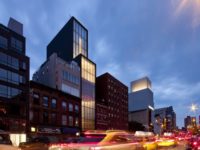The plot’s owner, commercial developer Trinity Real Estate, has plans to build there eventually, but in the meantime, it has turned the site over to the Lower Manhattan Cultural Council (LMCC) to use as a temporary cultural space. LMCC curator Adam Kleinman enlisted the New York firm Interboro Partners to design the project, which opened in September and occupies the majority of a 27,000-square-foot city block. From dawn to dusk, the public can explore the site, where the firm has created a hybrid sculpture park, event space, and tree nursery.
The organizers have named it LentSpace to reflect its transitory nature—temporarily existing somewhere between a public sculpture park and a walled-off private lot. The firm’s scheme, which cost a little more than $500,000 to construct (the total project budget is close to $1 million), teases the distinction between public and private urban space by taking up the material vocabulary of a building site.
While a chain link fence wraps the northern and western sides of the trapezoidal lot, allowing pedestrians a view in from the sidewalk, Interboro has enclosed the southern and eastern perimeter with its interpretation of a plywood construction barrier. “Trinity told us that they needed it to be fenced,” says Interboro partner Tobias Armborst. “We thought, we might as well have a fence that is not only bordering the site, not only delineating a space for art, but that itself becomes an object that is public, that is active.”
Mounted on steel posts, 26 panels form a plywood wall, but half of them pivot open to create entry points into the site. “What Interboro did was essentially create a blurred boundary,” says Kleinman.
The firm built long benches into the inside of each panel, which provide a place to sit and look across a gravel yard, where Kleinman has positioned work by eight artists. Toward the western side of the space, plywood appears again in large boxes planted with sapling trees and other vegetation. Interboro and Kleinman worked with a horticulturalist from New York Restoration Project to create the planters, which will allow trees nurtured at LentSpace to be replanted in other sites throughout the neighborhood when the project comes to an end.
The work in the inaugural sculpture exhibition, Points & Lines, also play with barricades and draw on a similar material palette to Interboro’s intervention. Artist Tobias Putrih, for example, riffs on the chain-link section of the perimeter, installing parallel sections of fencing that reach varying heights and create rough versions of formal garden pathways.
The exhibition runs through January, as does a series of additional programming, including graphic design commissions on the plywood wall, performances, and print media projects distributed in newspaper boxes. The space will then close for the winter, reopening in the spring with a new exhibition.
The LMCC’s two-year agreement to use the site has an option to renew, but Armborst says that Interboro designed the project with the idea that Trinity would build on the site within three to five years. Kleinman hopes LentSpace will lead other owners to reconsider how they use similar lots awaiting development. “This is an in-the-meantime project that could be a model for future types of land use,” he says.









Post a comment to this article
Report Abusive Comment